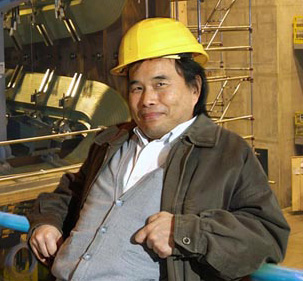Nationality: Japanese
“I think my job title is a little bit misleading,” reflects Tatsuya Nakada, departing spokesperson of the LHCb. “Normally a spokesperson is someone who represents the official view,” he explains, “but in the world of particle physics experiments, they have a function much closer to what is often called a project leader.”

This distinction probably reflects the fact that most particle physics experiments are not organized in a strict hierarchical way, says Tatsuya. Instead, they consist of many collaborating institutes that are independent both financially and structurally.
“The spokesperson cannot really tell people working on the project what to do – who is hired and fired,” Tatsuya explains. “There’s no legal or financial authority in that sense. The spokesperson is elected by the collaboration and entrusted primarily to lead the project – and leading is done more by persuasion and asking people to be reasonable.”
But even without wielding great power, the role is still very effective, insists Tatsuya. “This kind of structure works because in the end we all have the same common goal: for the experiment to be successful and to get interesting results.”
Tatusya has been involved in the LHCb experiment from the very beginning. “When the collaboration formed in 1995 I was elected as its first spokesperson,” he explains. “But I first came to CERN in the late 1970s as a PhD student to work on the Intersecting Storage Rings (ISR) experiment – the world’s first proton-proton collider.”
ISR closed down in 1983, and Tatsuya began work for the Swiss Institute for Nuclear Physics (SIN) in Villigen. While at SIN, Tatsuya initiated plans to build a ‘b factory’ – a machine producing large numbers of B mesons – at the institute. Although these plans were never implemented, similar ideas emerged in many other parts of the world, and b factories were finally built in Japan and USA in late 1990’s.
Various other proposals Tatsuya worked on, including an idea to turn CERN’s ISR tunnel into a b factory, fell by the wayside before the focus switched to using a proton collider – the newly planned LHC – to study b physics. Numerous different plans were drawn up, and the LHCb collaboration was finally formed in 1995.
Having served as LHCb spokesperson for more than a decade, and overseen the project’s planning, design and construction, Tatsuya stood down at the end of April 2008. “The next spokesperson will serve for a shorter term than me – probably only three years,” he says. “This is to be expected now that construction is finished and data collection is about to begin.” Tatsuya, however, remains part of the LHCb team. “I will continue to work on the experiment and at EPFL [the Swiss Federal Institute of Technology in Lausanne] where I’m a professor of physics,” he says.
